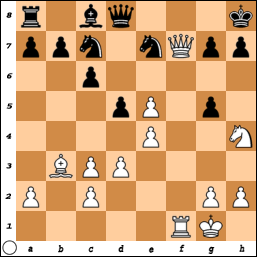Link for the tournament (San Sebastian, 1911) :
http://www.worldchesslinks.net/ezqa6.html
Lasker's Manual of Chess, page 76.
I will talk about a game you can see here :
http://www.chessgames.com/perl/chessgame?gid=1039850
After 8 BXP Q-K2, we have the following two paragraphs :
If 8 ... Kt-K2; 9 Kt-R4, White easily succeeds in advancing P-KB4 and obtains a lasting attack. A celebrated game, Schlechter versus Duras, played at the San Sebastian tournament ran the following course: 7 ... Kt-K2; 8 Kt-KR4 P-B3; 9 B-QB4 Kt-K1; 10 P-B4 BxKt; 11 PxB P-Q4; 12 B-Kt3 P-B3; 13 PxKP PxB; 14 RxRch. KxR; 15 Q-B3ch. K-Kt1; 16 R-KB1 Kt-B2; 17 Q-B7ch. K-R1.
Schlechter here gave his opponent a chance with 18 PxP, so changing the order of the moves. 18 Q-B8ch. QxQC 19 RxQch. Kt-Kt1; 20 PxP PxP; 21 Kt-B3. White threatens to throttle Black: 21 ... B-K3; 22 RxR KtxR; 23 KtxP Kt-B2; 24 KtxB KtxKt; 25 BxP, and White won the Ending.
Here is the position at the end of the first paragraph :

One of my problems is that the actual 18th move by White was 18.PxP (18.exd5), but Lasker continue after the first sentence with 18 Q-B-8ch., and he concudes ''and White won the Ending''. But the move 18.Q-B8+ IS NOT the game. In othe words, White DID NOT win the game as given in the series of moves 18 Q-B8ch. QxQC 19 RxQch. Kt-Kt1; 20 PxP PxP (etc.)
The other, problem (more important) is : what chance was Black given by the actual 18th move (18.cxd5) ?
Your help would be very much appreciated :)
Also :
Moves played (see the link above for chessgame.com) :
18.exd5 cxd5
19.Qf8+ Qxf8
20.Rxf8+ Ng8
Moves given in the Manual :
18.Qf8+ Qxf8
19.Rxf8+ Ng8
20.exd5 cxd5
Of course, in both cases we reach the same position after move 20.
The winner of the tournament was...

Thank you for your help.
Jean-Pierre Rhéaume, alias JPR
http://www.worldchesslinks.net/ezqa6.html
Lasker's Manual of Chess, page 76.
I will talk about a game you can see here :
http://www.chessgames.com/perl/chessgame?gid=1039850
After 8 BXP Q-K2, we have the following two paragraphs :
If 8 ... Kt-K2; 9 Kt-R4, White easily succeeds in advancing P-KB4 and obtains a lasting attack. A celebrated game, Schlechter versus Duras, played at the San Sebastian tournament ran the following course: 7 ... Kt-K2; 8 Kt-KR4 P-B3; 9 B-QB4 Kt-K1; 10 P-B4 BxKt; 11 PxB P-Q4; 12 B-Kt3 P-B3; 13 PxKP PxB; 14 RxRch. KxR; 15 Q-B3ch. K-Kt1; 16 R-KB1 Kt-B2; 17 Q-B7ch. K-R1.
Schlechter here gave his opponent a chance with 18 PxP, so changing the order of the moves. 18 Q-B8ch. QxQC 19 RxQch. Kt-Kt1; 20 PxP PxP; 21 Kt-B3. White threatens to throttle Black: 21 ... B-K3; 22 RxR KtxR; 23 KtxP Kt-B2; 24 KtxB KtxKt; 25 BxP, and White won the Ending.
Here is the position at the end of the first paragraph :

One of my problems is that the actual 18th move by White was 18.PxP (18.exd5), but Lasker continue after the first sentence with 18 Q-B-8ch., and he concudes ''and White won the Ending''. But the move 18.Q-B8+ IS NOT the game. In othe words, White DID NOT win the game as given in the series of moves 18 Q-B8ch. QxQC 19 RxQch. Kt-Kt1; 20 PxP PxP (etc.)
The other, problem (more important) is : what chance was Black given by the actual 18th move (18.cxd5) ?
Your help would be very much appreciated :)
Also :
Moves played (see the link above for chessgame.com) :
18.exd5 cxd5
19.Qf8+ Qxf8
20.Rxf8+ Ng8
Moves given in the Manual :
18.Qf8+ Qxf8
19.Rxf8+ Ng8
20.exd5 cxd5
Of course, in both cases we reach the same position after move 20.
The winner of the tournament was...

Thank you for your help.
Jean-Pierre Rhéaume, alias JPR


Comment